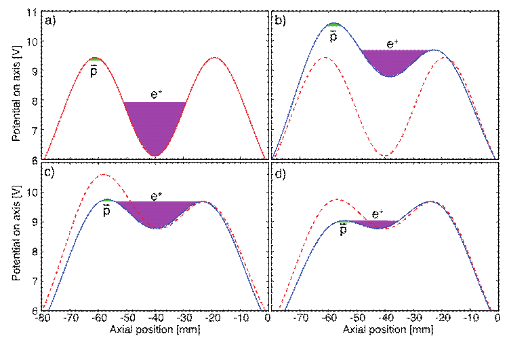Antihydrogen is synthesized by merging ensembles of antiprotons and positrons. As the goal is to trap them, it is of utmost importance that the antihydrogen synthesized is cold enough to be trapped. The magnetic trap used to trap them is at best around 50 micro-electron-volt deep; this is equivalent to about 0.5 Kelvin, or 0.5 degrees above absolute zero.
Historically several ways have been used to accomplish a merger of antiprotons and positrons that make antihydrogen, however the current one, that is the hitherto most successfully at making trappable antihydrogen consists simply of having antiprotons and positrons in two adjacent (and oppositely charged) potential wells and slowly merging the potentials as shown in the figure. The alert reader will notice that this means that the positrons must escape (to the left in the figure). This is true, and as it turns out, possibly an advantage, as the slow release (the merging of the potentials takes about one second) of the positrons result in so-called evaporative cooling, helping to ensure cold antihydrogen.

Potentials used for merging antiprotons and positrons.
(a) Initial potential, where the particles are held in separate wells.
(b) Post-positron EVC potential, the positrons have been evaporatively cooled
(c) Pre-merge potential serves to move the antiprotons closer to the positrons before starting the merger
(d) Post-merger potential, only few positrons and antiprotons are left
The step from (c) to (d) is the actual potential merger that is done in about one second.
